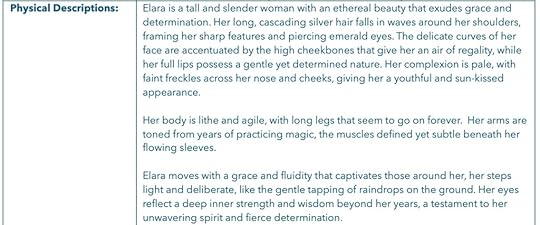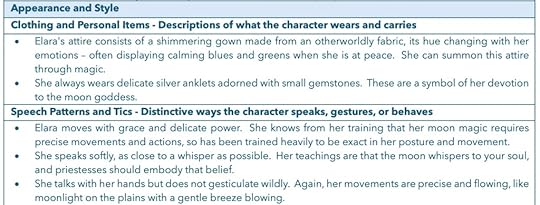Creating Compelling Characters (pt 1)
This six-part series will walk through the sections of my Character Template, describe how to use that template, and why you should go to this effort. I’ll sprinkle in some behind-the-scenes usage of the template as I’ve applied it to my latest writing efforts. My template is available for free to all subscribed members, so subscribe today and follow-along.
Focus on the physicalBringing a new character to life on the page can be an exciting and daunting task. One of the first elements to consider when crafting a character is their physical description. This crucial aspect sets the foundation for your character’s visual identity and helps readers connect with them on a sensory level. In this blog post, we’ll dive into using the character template for physical descriptions and explore why it matters in creating compelling characters.
The Power of Physical Descriptions
Physical descriptions serve as the initial impression readers have of your character. They create mental images that help readers differentiate between various characters in the story and immerse themselves in the world you’ve built. These details also offer opportunities for symbolism, adding depth and meaning to your characters through visual cues. For instance, a character with a prominent scar might symbolize their past struggles or resilience.
The top of the template

Building a Character from the Ground Up
Let’s explore an example using our character template. [] is a tall, lean man with short, curly brown hair and piercing blue eyes. A scar above his eyebrow adds an air of mystery. This physical description paints a vivid image in the reader’s mind, helping them connect with the character on a deeper level. It also creates intrigue, leaving readers wondering about the origins of the scar and what it might signify about [] past.
Notice the template has a single line for what could be a lot of descriptive text. Put whatever works for you in there. Here’s an example of a character I’ve been working on recently.

Crafting Authentic Physical Descriptions
When crafting physical descriptions, it’s essential to strike a balance between detail and authenticity. Be specific yet avoid descending into excessive or unrealistic details that may detract from the story rather than adding to it. Instead, focus on the elements of your character’s appearance that are relevant to their personality, backstory, or role in the narrative.
Incorporating Physical Descriptions into Your Writing
Physical descriptions can be seamlessly integrated into your writing in various ways. For example, you might describe a character’s appearance during an introduction or reveal their physical traits through the actions and interactions they have with other characters. Remember, physical descriptions should serve to enhance the story rather than detract from it, providing readers with valuable insights into your characters while keeping them engaged and invested in the narrative.
Continuing to use the sample for Elara, here’s how it shows up in my first draft:
She looked up at him as he stopped his flight. Her long, cascading silver hair fell in waves around her shoulders, framing her sharp features and piercing emerald eyes. The delicate curves of her face are accentuated by the high cheekbones giving her an air of regality, while her lips were full of promise, but set in determination as she stifled her crying. Her complexion was pale, but faint freckles were just visible in the poor light, giving her a youthful and sun-kissed appearance.
Notice this is almost a cut-and-paste of the description I built in the template. I won’t continue re-using the same parts of the description, but this made it simple for me to get the first impression out of my head, onto the page, and then shift back into the action of this part of the story.
Appearance and Style
In addition to the physical appearance, details about their style and mannerisms are essential for bringing them to life for the reader. Details such as clothing and personal items can reflect their personality and provide readers with a clear image of their unique style. For instance, [] leather jacket and wooden staff adorned with symbols from her home village offer insights into her tough exterior and strong connection to her roots.
A well-defined appearance not only adds visual appeal but also offers opportunities for symbolism and character development through subtle visual cues. These details help readers connect with the characters on a deeper level and create an immersive reading experience.
Part of a character’s style may be mannerisms, patterns of speech, or ‘ticks’ they have. Unique ways of speaking that reveal a character’s personality or background. For example, [] has a habit of pausing dramatically before delivering important information, emphasizing her wisdom and thoughtfulness.
Similarly, gestures and body-language can reveal a character’s thoughts, emotions, and intentions, providing readers with a clearer understanding of their motivations and reactions. Maybe [] often fiddles with her necklace when she’s nervous or uneasy, adding tension to sensitive scenes and highlighting her emotional vulnerability. These sorts of details add nuance and depth to the storytelling, allowing readers to connect more deeply with the characters and their experiences.
Looking at this part of the template for Elara gives some additional insight into how I might incorporate these details into her story:

A Visual Feast for Readers
Using the character template for physical descriptions is an essential aspect for me crafting compelling characters. These details provide readers with a tangible image of your characters, helping them connect on a sensory level and immerse themselves in the story. By focusing on authentic, relevant physical descriptions that add depth and meaning to your characters, you’ll create an engaging and memorable reading experience for your audience.
Stay tuned for our next blog post in this series, where we’ll delve into using the character template for personality traits and explore how they contribute to creating compelling characters.
Follow me on Amazon, GoodReads, or Facebook to get information about upcoming book releases.



